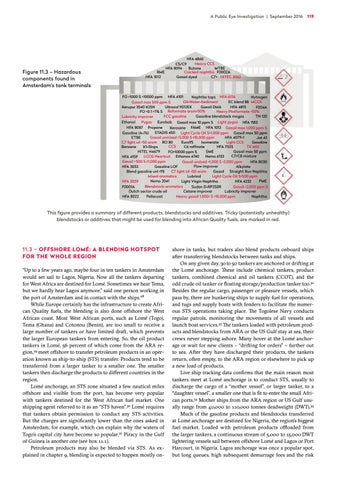A Public Eye Investigation | September 2016 119
Figure 11.3 – Hazardous components found in Amsterdam’s tank terminals
HFA 4860 Heavy CCS C5/C9 MTBE Butane HFA 8094 Cracked naphtha F0002A RME HFA 1012 Gasoil dyed C7+ HITEC 3062
FO >1000 S <10000 ppm HFA 4101 Naphtha tops HFA 6126 Nytrogen EC blend 88 MCCS Oil-Water-Sediment Gasoil max 500 ppm S Ultrazol 9012EX Gasoil DMA Kerupur 3540 K25N HFA 4815 F004A Heavy Platformate >50% FO >0.1 <1 % S Reformate arom>50% FCC gasoline Gasoline blendstock mogas TN 120 Lubricity improver Pygas Eurobob Gasoil max 10 ppm S Light pygas HFA 1183 Ethanol HFA 8087 Propane Kerosene FAME HFA 1012 Gasoil max 1,000 ppm S STADIS 450 Light Cycle Oil S<1,000 ppm Gasoil max 50 ppm Gasoline (A-76) Gasoil unmixed >5,000 S ≤10,000 ppm HFA 4079-1 ETBE Jet A1 Euro95 Gasoline C7 light oil >50 arom RO 80 Light CCS Isomerate CCS K1-Slops HFA 7025 C6 raffinate Benzene TX MIX HiTEL H4679 Gasoil max 50 ppm SME FO>10000 ppm S C7/C8 mixture LCCG Heartcut Ethanox 4740 Nemo 6133 HFA 4159 Gasoil > 500 S ≤1,000 ppm Gasoil undyed >1,000 S <2,000 ppm HFA 8030 Flow improver Gasoline LOF HFA 3033 Alkylate C7 light oil >50 arom Gasoil Straight Run Napthta Blend gasoline unl <95 Mixed aromatics Lubrizol Light Cycle Oil S<500 ppm PME Nemo 2041 HFA 4232 HFA 2039 Light Virgin Naphtha Blendstock aromatics Gasoil >2,000 ppm S F0001A Sudan D-RP250R Cetane improver Lubricity improver Dutch sector crude oil Heavy gasoil 1,000< S <10,000 ppm Naphtha Pellacoat HFA 8022
This figure provides a summary of different products, blendstocks and additives. Tricky (potentially unhealthy) blendstocks or additives that might be used for blending into African Quality fuels, are marked in red.
11.3 – OFFSHORE LOMÉ: A BLENDING HOTSPOT FOR THE WHOLE REGION “Up to a few years ago, maybe four in ten tankers in Amsterdam would set sail to Lagos, Nigeria. Now all the tankers departing for West Africa are destined for Lomé. Sometimes we hear Tema, but we hardly hear Lagos anymore,” said one person working in the port of Amsterdam and in contact with the ships.28 While Europe certainly has the infrastructure to create African Quality fuels, the blending is also done offshore the West African coast. Most West African ports, such as Lomé (Togo), Tema (Ghana) and Cotonou (Benin), are too small to receive a large number of tankers or have limited draft, which prevents the larger European tankers from entering. So, the oil product tankers in Lomé, 56 percent of which come from the ARA region,29 meet offshore to transfer petroleum products in an operation known as ship-to-ship (STS) transfer. Products tend to be transferred from a larger tanker to a smaller one. The smaller tankers then discharge the products to different countries in the region. Lomé anchorage, an STS zone situated a few nautical miles offshore and visible from the port, has become very popular with tankers destined for the West African fuel market. One shipping agent referred to it as an “STS haven”.30 Lomé requires that tankers obtain permission to conduct any STS activities. But the charges are significantly lower than the ones asked in Amsterdam, for example, which can explain why the waters of Togo’s capital city have become so popular.31 Piracy in the Gulf of Guinea is another one (see box 11.1). Petroleum products may also be blended via STS. As explained in chapter 9, blending is expected to happen mostly on-
shore in tanks, but traders also blend products onboard ships after transferring blendstocks between tanks and ships. On any given day, 30 to 50 tankers are anchored or drifting at the Lomé anchorage. These include chemical tankers, product tankers, combined chemical and oil tankers (CCOT), and the odd crude oil tanker or floating storage/production tanker too.32 Besides the regular cargo, passenger or pleasure vessels, which pass by, there are bunkering ships to supply fuel for operations, and tugs and supply boats with fenders to facilitate the numerous STS operations taking place. The Togolese Navy conducts regular patrols, monitoring the movements of all vessels and launch boat services.33 The tankers loaded with petroleum products and blendstocks from ARA or the US Gulf stay at sea, their crews never stepping ashore. Many hover at the Lomé anchorage or wait for new clients – “drifting for orders” – further out to sea. After they have discharged their products, the tankers return, often empty, to the ARA region or elsewhere to pick up a new load of products. Live ship tracking data confirms that the main reason most tankers meet at Lomé anchorage is to conduct STS, usually to discharge the cargo of a “mother vessel”, or larger tanker, to a “daughter vessel”, a smaller one that is fit to enter the small African ports.34 Mother ships from the ARA region or US Gulf usually range from 40,000 to 110,000 tonnes deadweight (DWT).35 Much of the gasoline products and blendstocks transferred at Lomé anchorage are destined for Nigeria, the region’s biggest fuel market. Loaded with petroleum products offloaded from the larger tankers, a continuous stream of 5,000 to 15,000 DWT lightering vessels sail between offshore Lomé and Lagos or Port Harcourt, in Nigeria. Lagos anchorage was once a popular spot, but long queues, high subsequent demurrage fees and the risk
